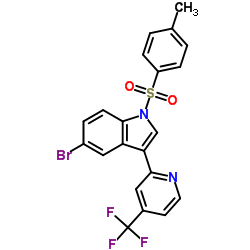Limiting role of 6-phosphogluconolactonase in erythrocyte hexose monophosphate pathway metabolism.
E Beutler, W Kuhl
文献索引:J. Lab. Clin. Med. 106(5) , 573-7, (1985)
全文:HTML全文
摘要
The natural product of the glucose-6-phosphate dehydrogenase reaction is 6-phosphoglucono-delta-lactone, which must be hydrolyzed to 6-phosphogluconic acid before it can be further metabolized by 6-phosphogluconate dehydrogenase. Because this lactone is very unstable, it has been uncertain whether the enzyme that hydrolyzes it, 6-phosphogluconolactonase, is required for functioning of the hexose monophosphate pathway. We have purified glucose-6-phosphate dehydrogenase, 6-phosphogluconolactonase, and 6-phosphogluconate dehydrogenase from human erythrocytes to the point where each enzyme is essentially free of each of the other activities. We constructed an artificial hexose monophosphate pathway from these enzymes, providing as substrate 14C-labeled glucose-6-phosphate either directly or by continual generation from 14C-glucose by yeast hexokinase and adenosine triphosphate. The oxidation of 6-phosphogluconic acid was estimated by measuring the CO2 formed. In the absence of a reduced nicotinamide-adenine dinucleotide phosphate (NADPH)-oxidizing system, such as oxidized glutathione (GSSG)-glutathione reductase or phenazine methosulfate, little CO2 was formed, and the presence of 6-phosphogluconolactonase did not affect the amount that was produced. When the hexose monophosphate pathway was stimulated by providing an NADPH-oxidizing system, CO2 was produced two and a half to five times as fast in the presence of 6-phosphogluconolactonase as in its absence. These studies suggest that 6-phosphogluconolactonase is required for the functioning of the hexose monophosphate pathway when the rate of oxidation of NADPH is accelerated.
相关化合物
| 结构式 | 名称/CAS号 | 分子式 | 全部文献 |
|---|---|---|---|
 |
6-磷酸葡萄糖酸脱氢酶
CAS:9073-95-4 |
C21H14BrF3N2O2S |
|
Initial characterization of the human central proteome.
2011-01-01 [BMC Syst. Biol. 5 , 17, (2011)] |
|
Complete sequencing and characterization of 21,243 full-leng...
2004-01-01 [Nat. Genet. 36 , 40-5, (2004)] |
|
The status, quality, and expansion of the NIH full-length cD...
2004-10-01 [Genome Res. 14 , 2121-7, (2004)] |
|
Lysine acetylation targets protein complexes and co-regulate...
2009-08-14 [Science 325(5942) , 834-40, (2009)] |
|
The DNA sequence and biological annotation of human chromoso...
2006-05-18 [Nature 441 , 315-321, (2006)] |